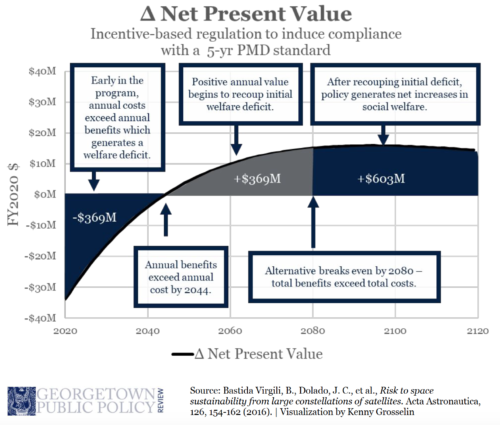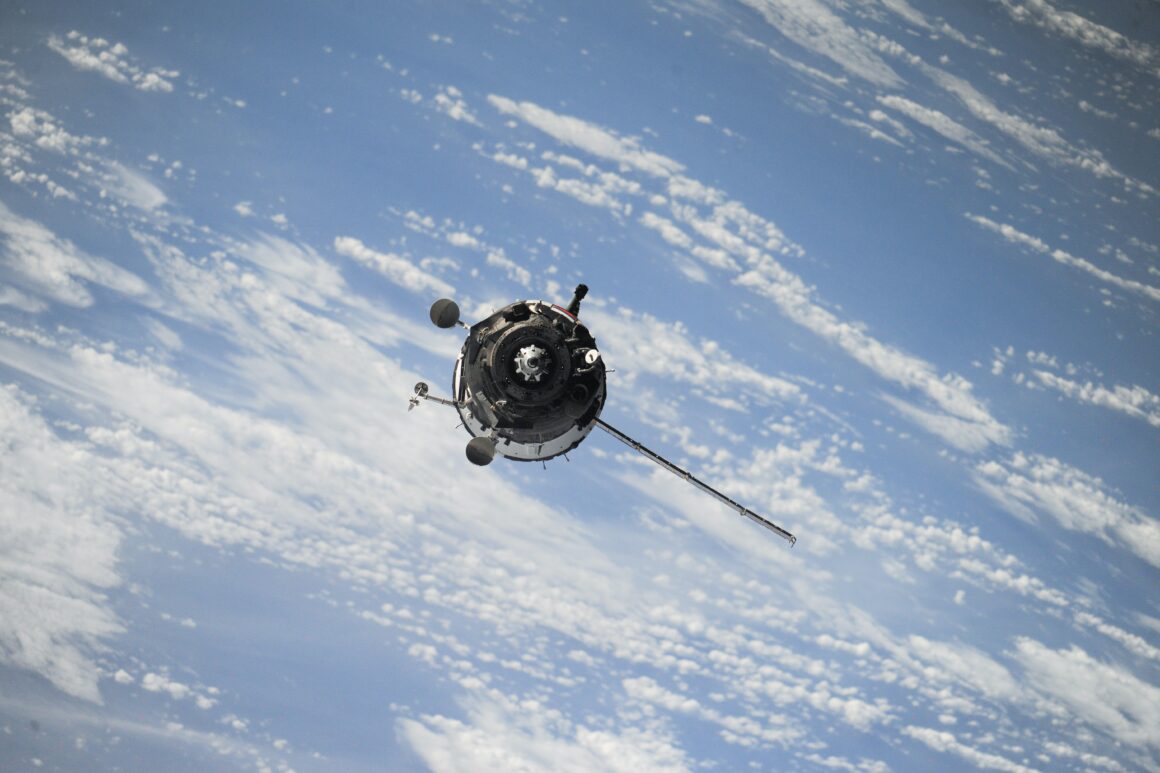The increasing amount of space debris in low Earth orbit poses a significant threat to current and future generations. “Space junk,” as it is colloquially known, can disrupt weather predictions, climate monitoring, arms control verification, and more. The policy solutions are expensive, but necessary.
Satellite activity in outer space is increasing rapidly. In an effort to deliver affordable broadband internet to the most remote corners of the globe, commercial companies are deploying large satellite constellations into low Earth orbit (LEO). As a result, the number of satellites operating in LEO could increase by 2,500% over the next 5 to 10 years. This drastic increase in satellite activity threatens to accelerate the creation of orbital debris, thereby jeopardizing the scientific, security and economic benefits the U.S. derives from satellites operating in LEO. Remediating this danger will require policy that overcomes the extraterritorial status of the space environment and balances the intergenerational disparity between the costs and benefits of space environmental management.
LEO starts 62 miles above the surface of Earth and extends to a ceiling of 1,242 miles. Since LEO is the lowest regime in which an object can orbit Earth, many of humanity’s most important space applications reside here. Remote sensing satellites predict weather patterns and monitor natural disasters while climate monitoring satellites in LEO serve as the most important source of data for climate science. From a security perspective, LEO satellites enable arms control verification, reduce the probability of a strategic miscalculation, and help dampen conflict escalation by providing timely and accurate intelligence on a rival’s military force. While the U.S. has enjoyed these public benefits for over 50 years, the commercial opportunities in LEO are rapidly expanding.
A dramatic reduction in launch costs has made large satellite constellations – formally defined as constellations with over 100 satellites – viable conduits for worldwide commercial broadband internet. As commercial companies pursue this opportunity, the number of operational satellites in LEO will more than double in 2020 and total LEO satellite activity will increase by an order of magnitude over the next five years. If this business model succeeds, it will bring affordable internet access to the most remote locations on Earth, a possibility that has led industry experts to predict that the global space economy will double to $1 trillion in annual revenue within twenty years.
These private interests have a public cost, namely congestion. Orbital debris – i.e., any human-made object in space that no longer serves a useful purpose – is a byproduct of human activity in space. Colloquially referred to as space junk, orbital debris includes large objects like used rockets and derelict satellites, small objects like nuts, bolts, and camera lenses, and miniscule objects like chips of paint and frozen satellite propellant chemicals. Since debris in LEO travels faster than 16,000 miles per hour, even a half-inch piece of debris can destroy an operational satellite.
The spatial density of debris is greatest in LEO. NASA has concluded that debris collisions represent the single largest threat to flight safety in LEO. And the debris problem will only get worse. Orbital collisions create a vicious cycle. Every collision creates more debris, which in turn increases the frequency of future collisions. In 2006, researchers showed that the accumulation of collision debris in LEO had surpassed the rate at which debris was decaying into the atmosphere. Beyond this critical tipping point, collisions – not additional human activity – had become the dominant source of new debris in LEO. Commercial companies are rapidly deploying large constellations into this volatile environment.
The extraterritorial status of the space environment complicates the formulation and implementation of sustainable space policy. When a satellite operator creates debris in LEO, direct and indirect costs accrue to other satellite operators in the form of increased collision risk, service interruptions and the design costs associated with satellite hardening, satellite maneuverability and satellite collision avoidance monitoring. The result is a “tragedy of the commons.” Commercial companies, acting in their own self-interest, deplete the shared resource – i.e. an uncongested LEO environment – they all need. Growing congestion, in turn, disrupts the public benefit of government satellite programs, threatens the quantity and quality of commercial satellite activity, and degrades the usability of LEO for all users now and in the future. Tragedies of the commons arise in fishing grounds and oil fields within the open oceans, shared parking in a community garage, taxis in a city, airport runways and air travel security queues. In these analogous examples, the narrow logic of producer and consumer behavior creates the congestion externality and proves insufficient to correct the underlying market failure.
Debris mitigation is one strategy for curtailing the accumulation of debris by proactively modifying how satellites are designed, operated and disposed. Since defunct satellites can remain in LEO for decades or centuries before falling back to Earth, many of the most effective mitigation measures occur after a satellite has completed its operational mission. For example, operators can perform a post-mission disposal maneuver to hasten the reentry of a satellite into Earth’s atmosphere by lowering its terminal altitude. A defunct satellite that quickly reenters Earth’s atmosphere has fewer collision opportunities and is thus less likely to contribute to the long-term debris population. Current U.S. regulation requires commercial operators to place satellites in a 25-year disposal orbit, though this standard is under increased scrutiny as the debris problem worsens.
Mitigation comes at a cost, of course. Stringent standards for maneuverability, hardening, reliability and post-mission disposal increase the size, weight, and complexity of a satellite. This in turn increases production costs and launch costs. Acting in isolation, producers lack the incentive to incur the cost of responsible mitigation, since it is unlikely any debris they generate will pose a direct or immediate threat to their own interests. Consequently, compliance with the 25-year post-mission disposal standard is estimated at 50-60%. Deliberate policy intervention is necessary to overcome these misaligned incentives.
The intergenerational timeline of these competing forces further complicates debris policy. Debris mitigation imposes present societal costs, while the preponderance of savings will be realized in the distant future. Many environmental policy problems exhibit similar characteristics. In these related policy domains, the rigid cost-benefit assumptions and standard practices prove obsolete, since they reward consumption in the present at the expense of future generations. When tackling these intergenerational problems, policy analysts must evaluate alternatives in a way that renders costs paid by one generation comparable to the savings experienced by another. Discounting long-term social benefits with the private return of capital (5-10%) or government-backed securities (3%) decisively undervalues the benefits future generations will enjoy. While the appropriate intergenerational social discount rate is a subject of academic debate, research published in 2015 found that 75% of 200 surveyed economists favor an intergenerational social discount rate of 2%. Unfortunately, the application of intergenerational discounting to the orbital debris problem is noticeably absent from the existing literature.
As an example of this logic, consider a notional policy that would reduce the maximum allowable reentry time for a retired satellite from 25 years to 5 years while also instituting a deposit-rebate program to induce increased compliance with debris mitigation standards. Such a policy conveys public and private costs and benefits. On the public side, aggressive mitigation decreases future costs by reducing the frequency of future collisions; however, complying with more stringent standards increases the near-term satellite expenditures of government agencies. From the commercial perspective, fewer collision hazards reduce satellite production costs and should encourage an increase in commercial activity in LEO. Conversely, increased regulatory burden acts as a tax – consumers will pay more for LEO satellite services, producers will receive less revenue, and the total number of surplus generating transactions between consumers and LEO satellite providers will decrease. The net change in social welfare associated with the alternative is the sum of these public and private considerations. The figure below demonstrates these competing dynamics by using debris accumulation projections, satellite design costs, and econometric assessments of the broadband internet market to estimate the long-term change in social value that results from this proposal.
In this example, the benefits of debris mitigation are initially limited and outstripped by the costs required to implement the proposal. Orbital debris mitigation has a gradual impact on the LEO environment. But by year 24 (2044), the annual benefit of debris mitigation matches the annual cost. It is at this time that society is better off on a year-to-year basis; however, additional time is required to overcome the deficit that builds during the early stages of the program when annual mitigation costs exceed the annual benefits. The break-even point occurs in year 60 (2080) – the point at which total accrued benefits exceed total accrued costs. Society is better off in the long run, but a significant upfront investment is required to achieve these benefits. This is just one potential alternative, but it represents the temporal disparities policy analysts in the Department of Commerce must grapple with to effectively solve the underlying problem.
The capacity of future generations to safely operate in LEO depends on society’s willingness to act in the present. The clock is ticking; the window for pre-emptive policy is vanishing. Orbital debris’ vicious cycle becomes more difficult to escape with every launch. In this policy domain, dithering is folly – it perpetuates the problem and makes remediation more difficult. Deliberate policy intervention is required to slow the growth of orbital debris to manageable levels. Orbital debris policy – like all intergenerational policy – must be made from a normative perspective that values equally the well-being of current and future operators in the LEO environment.

Note: Figure is the author’s original work based on data in the article “Risk to space sustainability from large constellations of satellites.” Calculations assume a 2% intergenerational discount rate and are based on debris accumulation projections, satellite design and launch costs, and econometric assessments of similar markets.
Disclaimer: The views expressed are those of the author and do not reflect the official policy or position of the U.S. Air Force, the U.S. Space Force, Department of Defense, or the U.S. government.
